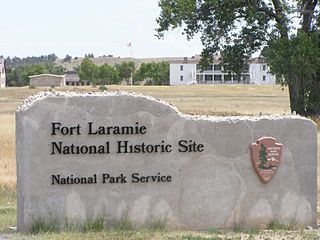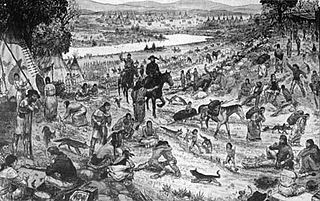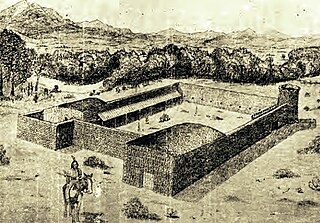
A mountain man is an explorer who lives in the wilderness. Mountain men were most common in the North American Rocky Mountains from about 1810 through to the 1880s. They were instrumental in opening up the various emigrant trails allowing Americans in the east to settle the new territories of the far west by organized wagon trains traveling over roads explored and in many cases, physically improved by the mountain men and the big fur companies originally to serve the mule train based inland fur trade.

The Tongue River is a tributary of the Yellowstone River, approximately 265 mi (426 km) long, in the U.S. states of Wyoming and Montana. The Tongue rises in Wyoming in the Big Horn Mountains, flows generally northeast through northern Wyoming and southeastern Montana, and empties into the Yellowstone River at Miles City, Montana. Most of the course of the river is through the beautiful and varied landscapes of eastern Montana, including the Tongue River Canyon, the Tongue River breaks, the pine hills of southern Montana, and the buttes and grasslands that were formerly the home of vast migratory herds of American bison.

The North Platte River is a major tributary of the Platte River and is approximately 716 miles (1,152 km) long, counting its many curves. In a straight line, it travels about 550 miles (890 km), along its course through the U.S. states of Colorado, Wyoming, and Nebraska.

James Pierson Beckwourth, was an American mountain man, fur trader, and explorer. Beckwourth was known as "Bloody Arm" because of his skill as a fighter. He was mixed-race and born into slavery in Virginia. He was freed by his white father and apprenticed to a blacksmith so that he could learn a trade.

Fort Laramie was a significant 19th-century trading post, diplomatic site, and military installation located at the confluence of the Laramie and the North Platte rivers. They joined in the upper Platte River Valley in the eastern part of the U.S. state of Wyoming. The fort was founded as a private trading post in the 1830s to service the overland fur trade; in 1849, it was purchased by the United States Army. It was located east of the long climb leading to the best and lowest crossing point of the Rocky Mountains at South Pass and became a popular stopping point for migrants on the Oregon Trail. Along with Bent's Fort on the Arkansas River, the trading post and its supporting industries and businesses were the most significant economic hub of commerce in the region.

The Assiniboine or Assiniboin people, also known as the Hohe and known by the endonym Nakota, are a First Nations/Native American people originally from the Northern Great Plains of North America.
Jim Baker (1818–1898) was a frontiersman, trapper, hunter, fur trader, explorer, army scout, interpreter, soldier, territorial militia officer, rancher, mine owner, toll keeper and mountain man. He was a friend of Jim Bridger and Kit Carson and one of General John C. Fremont's favorite scouts.

Ceran St. Vrain, born Ceran de Hault de Lassus de Saint-Vrain, was the American son of a French aristocrat who immigrated to the United States in the late 18th century; his mother was from St. Louis, where he was born. To gain the ability to trade, in 1831 he became a naturalized Mexican citizen in what is now the state of New Mexico. He formed a partnership with American traders William, George and Charles Bent; together they established the trading post of Bent's Fort. It was the only privately held fort in the West.
The enterprise that eventually came to be known as the Rocky Mountain Fur Company was established in St. Louis, Missouri, in 1822 by William Henry Ashley and Andrew Henry. Among the original employees, known as "Ashley's Hundred," were Jedediah Smith, who went on to take a leading role in the company's operations, and Jim Bridger, who was among those who bought out Smith and his partners in 1830. It was Bridger and his partners who gave the enterprise the name "Rocky Mountain Fur Company."

Jacques La Ramée, was a French-Canadian Métis coureur des bois, frontiersman, trapper, fur trader, hunter, explorer, and mountain man who lived in what is now the U.S. state of Wyoming, having settled there in 1815. His name appears in several spellings, including La Ramee, Laramée, LaRamée, La Ramie, La Rami, La Remy, and Laramie. La Ramée is credited as an early explorer of what is now called the Laramie River of Wyoming and Colorado. The city of Laramie, Wyoming, with an Americanized spelling, was later named for him.

Fort Saint Vrain was an 1837 fur trading post built by the Bent, St. Vrain Company, and located at the confluence of Saint Vrain Creek and the South Platte River, about 20 miles (32 km) east of the Rocky Mountains in the unorganized territory of the United States, in present-day Weld County, Colorado. A historical marker notes the place where Old Fort St. Vrain once stood, today at the end of Weld County Road 40, located about seven miles north of Fort Vasquez, Colorado. Among those who helped to establish the fort was Ceran St. Vrain, after whom it was named.

Pierre's Hole is a shallow valley in the western United States in eastern Idaho, just west of the Teton Range in Wyoming. At an elevation over 6,000 feet (1,830 m) above sea level, it collects the headwaters of the Teton River, and was a strategic center of the fur trade of the northern Rocky Mountains. The nearby Jackson's Hole area in Wyoming is on the opposite side of the Tetons.

The Trapper's Trail or Trappers' Trail is a north-south path along the eastern base of the Rocky Mountains that links the Great Platte River Road at Fort Laramie and the Santa Fe Trail at Bent's Old Fort. Along this path there were a number of trading posts, also called trading forts.

The Rocky Mountain Rendezvous was an annual rendezvous, held between 1825 to 1840 at various locations, organized by a fur trading company at which trappers and mountain men sold their furs and hides and replenished their supplies. The fur companies assembled teamster-driven mule trains which carried whiskey and supplies to a pre-announced location each spring-summer and set up a trading fair. At the end of the rendezvous, the teamsters packed the furs out, either to normally the British Companies to Fort Vancouver in the Pacific Northwest for the British companies or to one of the northern Missouri River ports such as St. Joseph, Missouri, for American companies. Early explorer and trader Jacques La Ramee organized a group of independent free trappers to first ever gather as early as 1815 at the junction of the North Platte and the Laramie Rivers after befriending numerous native American tribes.
Fort Jackson was a fur trading post near the present-day town of Ione in Weld County, Colorado that operated from 1837 to 1838. It was one of the four trading posts along the South Platte River area. Nearby posts and competitors were Fort Vasquez, Fort Lupton, and Fort Saint Vrain.
The early history of the Arkansas Valley in Colorado prior to the Colorado Gold Rush of 1859 saw a number of trading posts and small settlements established in the Arkansas and South Platte valleys including Bent's Fort and Fort Pueblo

The fur trade in Montana was a major period in the area's economic history from about 1800 to the 1850s. It also represents the initial meeting of cultures between indigenous peoples and those of European ancestry. British and Canadian traders approached the area from the north and northeast focusing on trading with the indigenous people, who often did the trapping of beavers and other animals themselves. American traders moved gradually up the Missouri River seeking to beat British and Canadian traders to the profitable Upper Missouri River region.

Fort Lupton, located in the city of the same name, was a trading post from 1836 or 1837 to 1844. After operating as a stage coach station and used as a house, the building fell into disrepair and crumbled to all but a portion of one wall by the early 20th century. The trading post has been reconstructed yards away from its original site and is now part of the South Platte Historical Park in northwestern Fort Lupton, Colorado.

Fort Davy Crockett, also called Fort Misery, was a trading post of the late 1830s and early 1840s. The site is located within Browns Park National Wildlife Refuge in Moffat County, Colorado. Unlike most trading posts within the confines of the current state of Colorado, Fort Davy Crockett was located west of the Rocky Mountains in what is now northwestern Colorado.
Alexander Barclay was a British-born frontiersman of the American West. After working in St. Louis as a bookkeeper and clerk, he worked at Bent's Old Fort. He then ventured westward where he was a trapper, hunter, and trader. Barclay entered into a common-law relationship with Teresita Sandoval, one of the founders of the settlement and trading post El Pueblo. He helped settle Hardscrabble, Colorado and built Fort Barclay in New Mexico.















